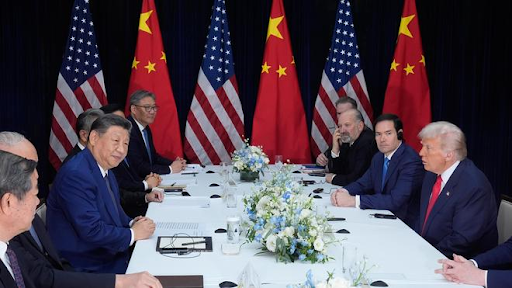



India restricted Bangladeshi exports via land ports in response to Bangladesh’s trade barriers on Indian goods. The curbs aim to promote local industries, reflect diplomatic tensions, and reduce dependence on Bangladesh for regional connectivity. Key infrastructure like NH-6 and the Kaladan project offer alternate trade routes for Northeast India.

Copyright infringement not intended
Picture Courtesy: THE HINDU
India has imposed restrictions on Bangladeshi exports through land ports, citing reciprocal measures after Bangladesh limited Indian yarn imports via land routes.
The Directorate General of Foreign Trade (DGFT), under the Ministry of Commerce and Industry, issued a notification that bans ready-made garments (RMG) from Bangladesh from entering India through land ports.
These garments can now only pass through only two seaports—Kolkata and Nhava Sheva (Mumbai)—where they face mandatory inspections.
India has restricted several other Bangladeshi commodities, such as plastic goods, wooden furniture, juices, carbonated drinks, bakery items, confectionery, cotton yarn, and dyes, from entering through land ports in Assam, Meghalaya, Tripura, Mizoram, and specific posts in West Bengal (Fulbari and Changrabandha).
Reciprocity for Bangladesh’s Trade Barriers
Bangladesh has imposed restrictions on Indian exports, in April 2025, banned Indian yarn exports through land ports, forcing them to use costlier sea routes. It terminated Indian rice exports via the Hili and Benapole Integrated Check Posts (ICPs) in West Bengal.
These measures have discouraged Indian exporters, as land routes are faster and cheaper. Indian limits on Bangladeshi goods reflect these restrictions, to restore fairness in trade.
Promoting Local Manufacturing
Restrictions target commodities that Northeastern states can produce; such as garments, furniture, and processed foods. By limiting cheap Bangladeshi imports, India aims to promote its domestic industries under the Atmanirbhar Bharat initiative.
For years, Bangladesh has enjoyed easy access to Northeast India’s markets, while Indian goods faced high transit costs and barriers in Bangladesh. The curbs aim to level the playing field and prompt economic growth in Assam, Meghalaya, Tripura, and Mizoram.
Diplomatic Tensions and Strategic Messaging
Relations between India and Bangladesh have been unstable since the interim government, led by Muhammad Yunus, took over in 2024.
Yunus’s remarks in China, describing India’s northeastern states as “landlocked” and positioning Bangladesh as the region’s sole gateway to the ocean, provoked strong reactions.
India’s trade restrictions signal displeasure with Bangladesh’s diplomatic closeness toward China and its interim government’s actions, such as banning the Awami League.
The curbs follow India’s withdrawal of a transshipment facility in April 2025, which had allowed Bangladesh to export goods to third countries via Indian ports.
Increased Costs and Delays => Rerouting RMG exports to seaports raises transportation costs and extends delivery times. The restrictions could weaken Bangladesh’s export competitiveness.
Economic Strain => Bangladesh’s RMG industry, valued at $38 billion globally in 2023, depends heavily on exports to India. With 93% of its $700 million RMG exports to India previously using land ports, the curbs disrupt a vital revenue stream.
Empowering Domestic Manufacturers
The Confederation of Indian Textile Industry (CITI) predicts that restricting Bangladeshi RMG imports will create opportunities for Indian manufacturers. By redirecting cotton yarn supplies to domestic markets, India can meet rising demand and reduce dependence on imports.
Strategic Realignment
India is reducing its dependence on Bangladesh for regional connectivity. The Shillong-Silchar highway project (NH-6) and the Kaladan Multi-Modal Transit Transport Project in Myanmar offer alternative trade routes, connecting Northeast India to Kolkata and Vizag via sea, bypassing Bangladesh.
Shillong-Silchar Highway (NH-6)
This four-lane highway connects Mawlyngkhung (Meghalaya) to Panchgram (Assam). It will cut travel time from 8.5 hours to 5 hours and is the first high-speed corridor in the Northeast.
Implemented by the National Highways & Infrastructure Development Corporation Limited (NHIDCL) under the Ministry of Road Transport and Highways, it will be completed by 2030.
Kaladan Multi-Modal Transit Transport Project
This India-Myanmar project links Kolkata and Vizag to Sittwe port (Myanmar) via sea, then to Paletwa via inland waterways, and to Zorinpui (Mizoram) by road.
It provides Northeast India with ocean access without relying on Bangladesh, supporting India’s Act East Policy and reducing vulnerability to Bangladesh’s trade policies. The project will be fully operational by 2030

Must Read Articles:
India Bangladesh Border Dispute
Sheikh Hasina's exit could disrupt India-Bangladesh
Source:
|
PRACTICE QUESTION Q. Critically analyze the role of external powers such as China and the United States in influencing India-Bangladesh relations. 150 words |




© 2026 iasgyan. All right reserved